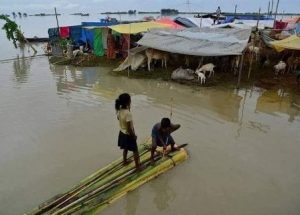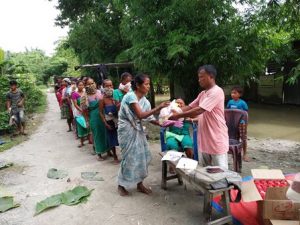Flood and COVID-19: Assam under Dual Threat
State and the people should focus more on the factors causing flood every year, and start taking preventive measures on how to lessen the effect of flood in the region, instead of focusing to deal with its aftermath.
Amidst the coronavirus pandemic, Assam is yet again witnessing the overflowing of Brahmaputra and its tributaries above the danger mark. Floods ravage different parts of Assam every year like clockwork, with just the start of the monsoon season in June till August.  The catastrophic flood has already affected lakhs of people every day. It has so far affected around 70 lakh people with86 deaths across the state. It has spread 24 districts of the 33 districts of Assam. The Assam State Disaster Management Authority (ASDM) reported,” At present 2,400 villages are underwater and 1,10,323.54 hectares of crop area is damaged”. The entire Brahmaputra Valley, which includes Kaziranga National Park, a UNESCO recognised world heritage site, is completely submerged in water and it has so far witnessed the death of at least 51 animals and rescue of around 100 animals.
The catastrophic flood has already affected lakhs of people every day. It has so far affected around 70 lakh people with86 deaths across the state. It has spread 24 districts of the 33 districts of Assam. The Assam State Disaster Management Authority (ASDM) reported,” At present 2,400 villages are underwater and 1,10,323.54 hectares of crop area is damaged”. The entire Brahmaputra Valley, which includes Kaziranga National Park, a UNESCO recognised world heritage site, is completely submerged in water and it has so far witnessed the death of at least 51 animals and rescue of around 100 animals.
The authorities have set up around 397 relief camps and distribution centres across 17 districts where 44,498 people are currently taking shelter. However, this time, it is just not the threat of rising water levels, but the ongoing COVID-19 pandemic threatening those in flood-relief camps, adding high risk to already vulnerable. Lakhs of people have already lost their homes, livelihoods, belongings and documentation, and they are shifted to relief camps. The living conditions in relief camps can easily be imagined with compact space, huge numbers of people and shared commodities. This will make it really difficult to follow the most essential norm of ‘social distancing’ to avoid COVID-19. After an initial low count of COVID-19 cases, the state saw a spike in the number of cases with the government’s decision to allow interstate travel that has further elevated the situation with the flow of more and more people coming back to their home state. The state has so far recorded 25,902 cases and 58 deaths.
The ASDM has drawn up ‘standard operating protocol’ to deal with the risk of the virus spreading in the flood relief camps. M.S Manivannam, chief executive officer, ASDM, told, “every district is following the SOP in their relief camps, each district has identified camps and how many people will be there in each camp, this time the space is three times than it usually is”. The authorities and some NGOs are providing hand washing facilities, masks and have also provided medical teams in each relief camp. Despite such measures taken by the state, it will be really hard to maintain the precautionary measures if the flood gets worse as it will bring in more and more people in these relief camps.
Many people are sharing posts on social media how ignorant national media have been towards such natural calamity in the north-eastern region of India.
Also Read : Baghjan Oil Leak and Blowout: Questions Remain
Paris Pikul Gogoi, a student wrote, “In context of presentation of news in India, it is observed that most of the news is circulated, analysed and discussed within the sphere of mainland India, geographical remoteness of the north-eastern region and their distinguishing culture make it a constraining factor towards recognising their problem as a problem of greater India. However, hypocritically, when somebody from this region achieves something in international scenario, their identity is assimilated to the more significant identity of the Indian nation and whenever natural disaster or calamity struck the region, the national media overlooks the satisfactory coverage of such incidents in northeast India”
At the same time, in contemporary times it is wrong to assume that national media is completely reluctant to news of the north-eastern region. In some instances, they left no stone unturned to cover news on incidents like Karbi Anglong mob lynching, G S Road incidents, terrorist activities in Manipur, etc. From this we can easily predict how the national media is keen to portray a primitive stereotypical image of the north-eastern region of India, their enthusiasm to cover such news is clearly visible on how much screen time is given for its presentation. Where does this enthusiasm go when the people of this region face genuine issues of natural calamity like flood, landslides or forceful displacement every year. The issues of this region should be addressed with the same intensity as the problems of others not merely as a projection to feed stereotypes. They deserve to be given as much importance as the news of any part of India.
 On the other hand, it is also important to discuss, why is Assam prone to flood every year? Assam is a flood-prone state with its vast network of rivers. A combination of both natural and man-made factors has contributed to it. At the crux of this, it is the very nature of the Brahmaputra: unstable and dynamic. It is arguably the most heavily sediment charge river of its size in the world, adding to that is the peculiar topography of the region: Assam’s flood plains are surrounded by hills on almost all the sides. The vast amount of sediment comes from Tibet, where the river originates – along the way more sediment are deposited. By the time the river enters Assam, it deposits a vast amount of this silt, which leads to erosion and flood.
On the other hand, it is also important to discuss, why is Assam prone to flood every year? Assam is a flood-prone state with its vast network of rivers. A combination of both natural and man-made factors has contributed to it. At the crux of this, it is the very nature of the Brahmaputra: unstable and dynamic. It is arguably the most heavily sediment charge river of its size in the world, adding to that is the peculiar topography of the region: Assam’s flood plains are surrounded by hills on almost all the sides. The vast amount of sediment comes from Tibet, where the river originates – along the way more sediment are deposited. By the time the river enters Assam, it deposits a vast amount of this silt, which leads to erosion and flood.
Again, the region is prone to earthquake; a devastating earthquake occurred in 1950, which led to instability of the river, the level of Brahmaputra rose by two meters in Dibrugarh area in eastern Assam. Earlier big floods would come once in 10 years, but now it is affecting the people every year.
Besides the natural factors, there are man-made factors which have led to severity of floods in the area like large-scale deforestation in the name of developmental projects and population growth in catchment areas, which led to higher sedimentation, people settling in such areas restricts the space for the flow that leads to overflow of the river.
One of the major defaults for flood management is the total dependency on embankments by the state.
Also Read : Rising number of environmental refugees in the world
Assam began constructing embankments in 1960s, it spent around 30,000 crore in constructing these embankments, and these embankments need regular maintenance to avoid breaching and the state has entirely failed their maintenance. ”Embankments are repaired or constructed from the state disaster response fund, but the scheme for release of money was submitted in may, when the flood season starts in Assam. The quality of work suffers obviously” an official said declining to be quoted. Water resource officials blamed delay on coronavirus and associated lockdown.
Another man-made factor can be the dams, that are built scientifically to generate energy and to control flood in downstream areas, but due to the environmental changes, there is thinning of glaciers in high mountains from which the tributaries of Brahmaputra originates. The continuous melting of glaciers and unpredictable weather of the region puts such dams at risk, breaching of this dam can further lead to flood havoc in plains of Assam like in Kerala floods.
The natural factors that lead to floods in Assam cannot be regulated by us, but the man- made factors like deforestation, encroachment, embankments and construction of dams should be addressed immediately. Just after the blow out in Baghjan, the flood has devastated the innocent lives, further adding to the worse situation. The Central Water Commission warned that the water level will increase more in days to come, what more does Assam have to face? It is high time for the state and the people to emphasise more on the factors that is causing flood every year and start taking preventive measures on how to lessen the effect of flood in the region, instead of focusing to deal with its aftermath. Otherwise, the same cycle of flood affecting Assam and its people will be repeated and discussed yet again next year.
